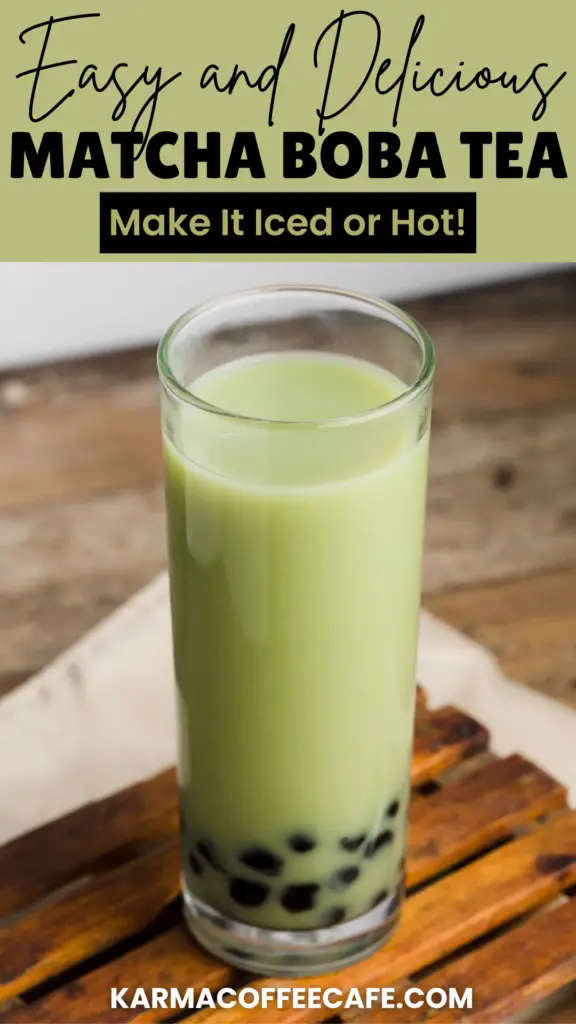Matcha boba tea combines two exciting elements: matcha’s vibrant, earthy flavor and the chewy texture of boba pearls.
Matcha is finely ground green tea leaves, traditionally from Japan, known for its bright green color and rich antioxidant content.
It has been enjoyed for centuries, offering numerous health benefits like boosting energy and promoting relaxation due to the presence of L-theanine.
Boba, or tapioca pearls, are made from cassava starch.
When cooked, these pearls become soft and chewy, adding a fun, unique texture to drinks.
Boba tea, often called bubble tea, originated in Taiwan and has grown in popularity worldwide, especially in North America and Europe.
In this post, we’ll show you how to easily make this delicious drink at home!
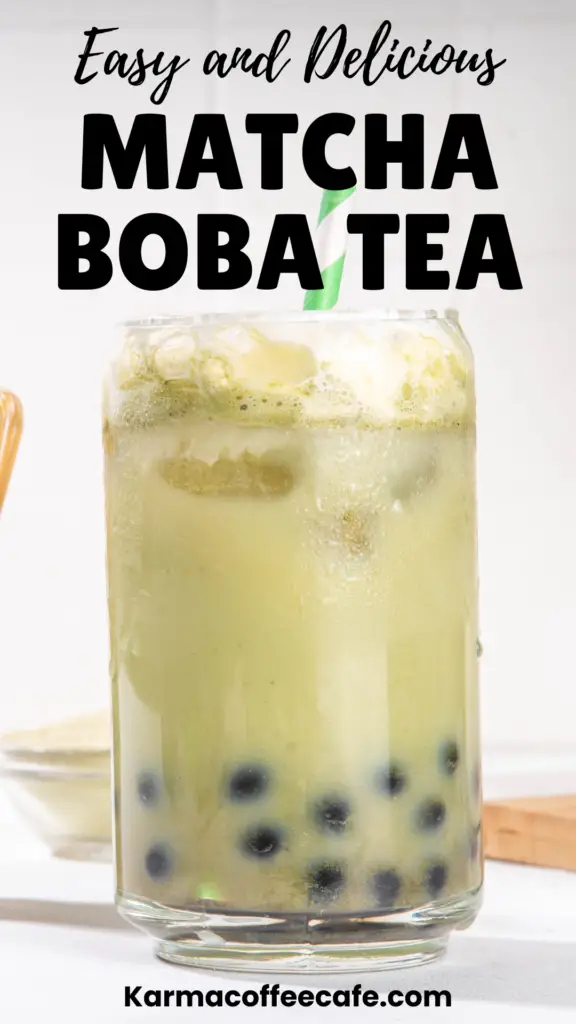
How to Make Matcha Boba Tea: At A Glance
- Cook tapioca pearls: Boil for 5-8 minutes, then marinate in syrup to prevent sticking.
- Prepare matcha: Whisk 1-2 teaspoons of matcha with hot water until smooth.
- Assemble: Add cooked boba, ice (optional), milk, and whisked matcha to a glass.
- Serve: Stir and enjoy immediately for the best texture!
Why Make Matcha Boba Tea at Home?
There are several great reasons to make matcha boba tea at home.
First, it’s more cost-effective than buying from a café.
You can create multiple servings for the price of one store-bought drink.
Second, making it at home allows full customization.
You get to choose your favorite non-dairy milk like almond, oat, or coconut, and control the level of sweetness with natural sweeteners like maple syrup or coconut sugar.
Finally, homemade matcha boba tea ensures better quality, allowing you to use premium ingredients like ceremonial-grade matcha for a richer taste and added health benefits.
Ingredients You’ll Need
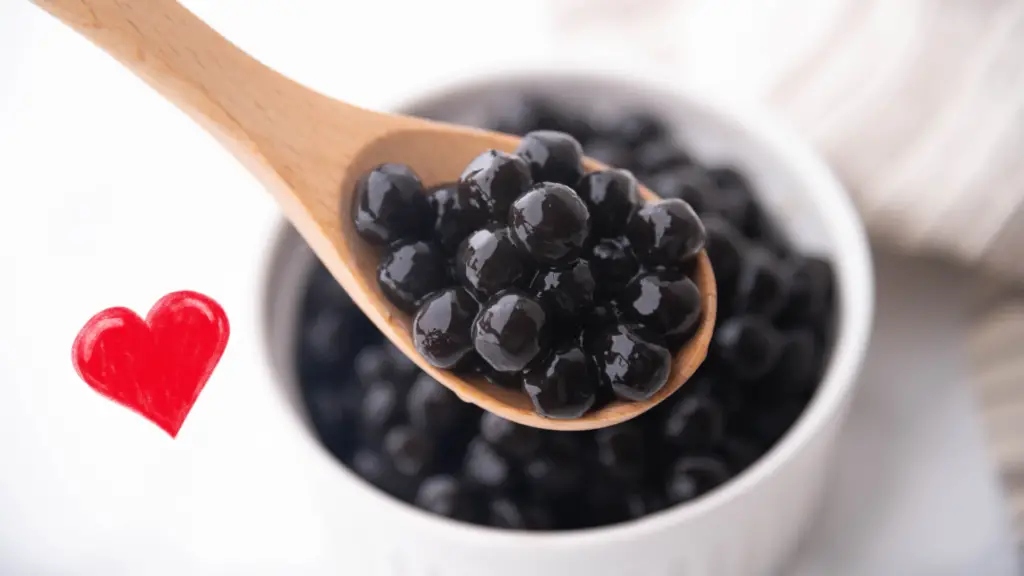
Matcha
Use 1-2 teaspoons of ceremonial-grade matcha powder for each serving.
This ensures a rich, vibrant flavor and maximizes the health benefits of the tea.
Tapioca Pearls (Boba)
You’ll need ½ cup of tapioca pearls.
Quick-cooking boba takes around 5-8 minutes to prepare, while traditional boba might require longer boiling times.
Always follow the package instructions for the best results.
Milk Options
Choose 1 cup of plant-based milk for a vegan version.
Options include:
- Almond milk for a light, nutty flavor.
- Oat milk for a creamy texture.
- Coconut milk for a tropical twist.
- Soy milk for a neutral, smooth taste.
- Alternatively, you can use cow’s milk if you’re not following a vegan diet.
Sweeteners
Add 1-2 tablespoons of your preferred sweetener.
Natural options include:
- Maple syrup for a rich, caramel-like sweetness.
- Coconut sugar for a more subtle, nutty flavor.
- Honey if not strictly vegan.
Water
Use 2-3 tablespoons of hot water to whisk the matcha powder into a smooth, clump-free consistency before combining it with the other ingredients.
Step-by-Step Instructions
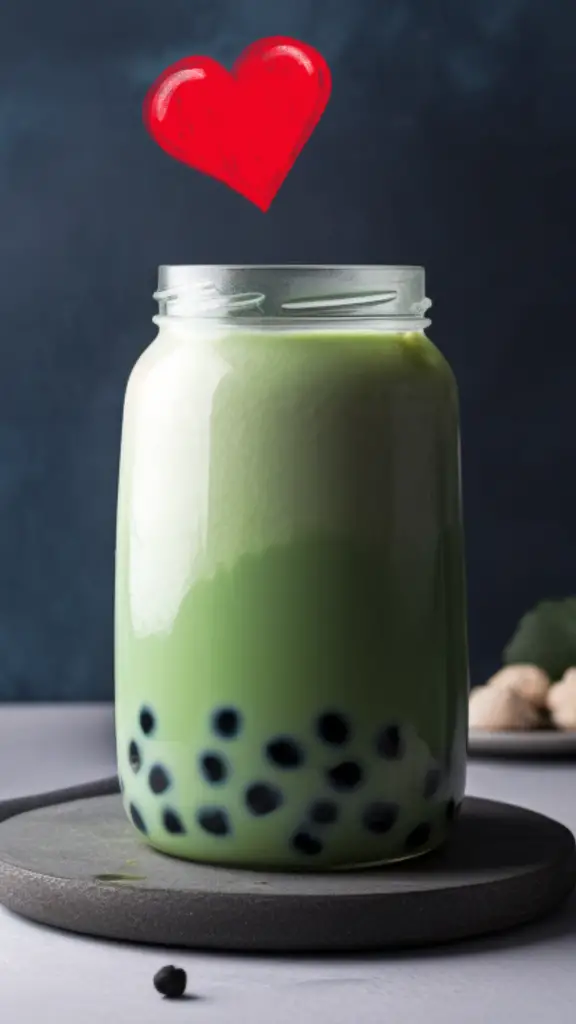
1. Cook the Tapioca Pearls
- Boil the Pearls: Bring 3 cups of water to a rolling boil in a medium saucepan. Add ½ cup of tapioca pearls and stir gently to prevent sticking. Cook for 5-8 minutes (or follow the specific instructions on the package if using a traditional variety) until the pearls become soft and chewy.
- Sweeten the Boba: Once cooked, strain the pearls and transfer them to a bowl. Marinate them in 2 tablespoons of brown sugar syrup (or another sweetener like maple syrup). Stir to ensure each pearl is coated and let sit for about 15 minutes to absorb the sweetness.
- Prevent Sticking: To keep the boba from sticking together, mix them with the syrup immediately after draining.
2. Prepare the Matcha
- Whisk the Matcha: In a small bowl, sift 1-2 teaspoons of matcha powder to remove any clumps. Add 2-3 tablespoons of hot water (around 175°F or 80°C) and whisk vigorously using a bamboo whisk (or immersion blender) until smooth and frothy.
- Avoid Dilution: Use as little hot water as necessary to dissolve the matcha, especially if you’re making an iced version, to prevent the drink from becoming too watery.
3. Assemble the Drink
- Layer the Ingredients: Divide the sweetened tapioca pearls evenly between two glasses. For an iced version, add a handful of ice cubes on top of the boba. Next, pour 1 cup of milk (almond, oat, or other options) into each glass.
- Add the Matcha: Slowly pour the whisked matcha over the milk, aiming for the center to create distinct layers if desired. Stir gently to combine the layers, or leave them separated for a visual effect.
Serve immediately with a wide straw to enjoy both the drink and the chewy boba!
Tips for the Perfect Matcha Boba Tea

Adjusting Sweetness
One of the key advantages of making matcha boba tea at home is the ability to adjust the sweetness exactly to your liking.
Depending on your preference, you can add more or less sweetener.
If you enjoy a mildly sweet drink, start with 1 tablespoon of sweetener, such as maple syrup or coconut sugar.
If you prefer a sweeter tea, increase it to 2 tablespoons or more.
The great thing about homemade boba tea is that you control everything, from the type of sweetener to its intensity.
Natural sweeteners like maple syrup offer a rich, caramel-like sweetness without being overpowering.
Layering the Drink
As we touched on earlier, creating beautiful, distinct layers in your matcha boba tea is easier than you think.
Start by pouring the sweetened tapioca pearls into the bottom of the glass.
Then, slowly add ice cubes if you’re making an iced version.
Next, gently pour the milk of your choice over the pearls.
Finally, pour the whisked matcha down the center of the glass, letting it flow slowly onto the milk or ice.
The key here is to pour slowly to prevent the layers from mixing too quickly.
If done correctly, you’ll see a stunning contrast between the dark boba at the bottom, the creamy milk in the middle, and the vibrant green matcha on top.
While visually appealing, these layers will eventually mix when you stir the drink or sip through the straw, blending all the flavors together.
Storing Boba
If you’re preparing boba in advance or have leftovers, proper storage is essential to maintain their chewy texture.
After cooking the tapioca pearls, marinate them in a simple syrup made with equal parts water and sugar (or use maple syrup).
This prevents the pearls from sticking together and drying out.
Store the boba at room temperature in the syrup, and try to use them within a few hours for the best texture.
Avoid refrigerating the boba, as this can cause them to become hard and lose their chewiness.
Variations and Customizations
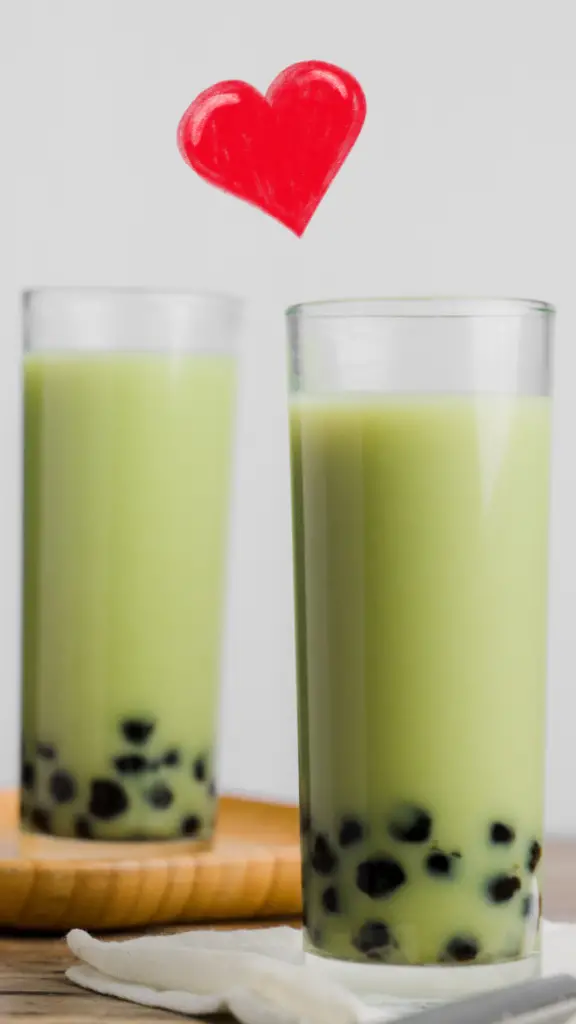
Hot vs. Iced Versions
Matcha boba tea can be enjoyed both iced and hot, offering flexibility depending on your mood or the season.
For a hot version, simply skip the ice cubes.
Heat the milk (whether almond, oat, or any other milk) until it’s warm but not boiling.
This will help retain the smooth texture of the milk while blending well with the matcha.
Whisk the matcha as usual using hot water, and pour it over the warm milk.
The chewy tapioca pearls will still give that delightful texture, even in a hot drink.
Flavored Versions
You can easily add a fruity twist to your matcha boba tea by incorporating fruit purees.
Popular options include strawberry or mango puree, which add a natural sweetness and bright color to the drink.
Simply add a tablespoon or two of fruit puree to the bottom of the glass along with the cooked boba before layering in the ice, milk, and matcha.
The fruit not only enhances the flavor but also provides a refreshing burst of natural sweetness, making the drink even more exciting.
For a richer flavor combination, consider pairing the earthy matcha with sweet fruits like peaches or lychee.
Each addition creates a unique experience with every sip.
Using Different Milks
One of the best parts about making matcha boba tea at home is the ability to experiment with different kinds of milk.
If you’re looking for a creamy texture, oat milk is an excellent choice.
It blends smoothly with matcha and adds a natural sweetness without being too heavy.
Almond milk, on the other hand, provides a lighter, slightly nutty flavor, which complements the earthy notes of matcha.
If want a tropical twist, coconut milk can give the drink a subtle, sweet richness, while soy milk offers a neutral, balanced flavor.
Each plant-based milk brings its own character to the tea, so you can choose whichever fits your taste best.
And if you’re not vegan, cow’s milk works just as well, providing a familiar creaminess.
Health Benefits of Matcha Boba Tea
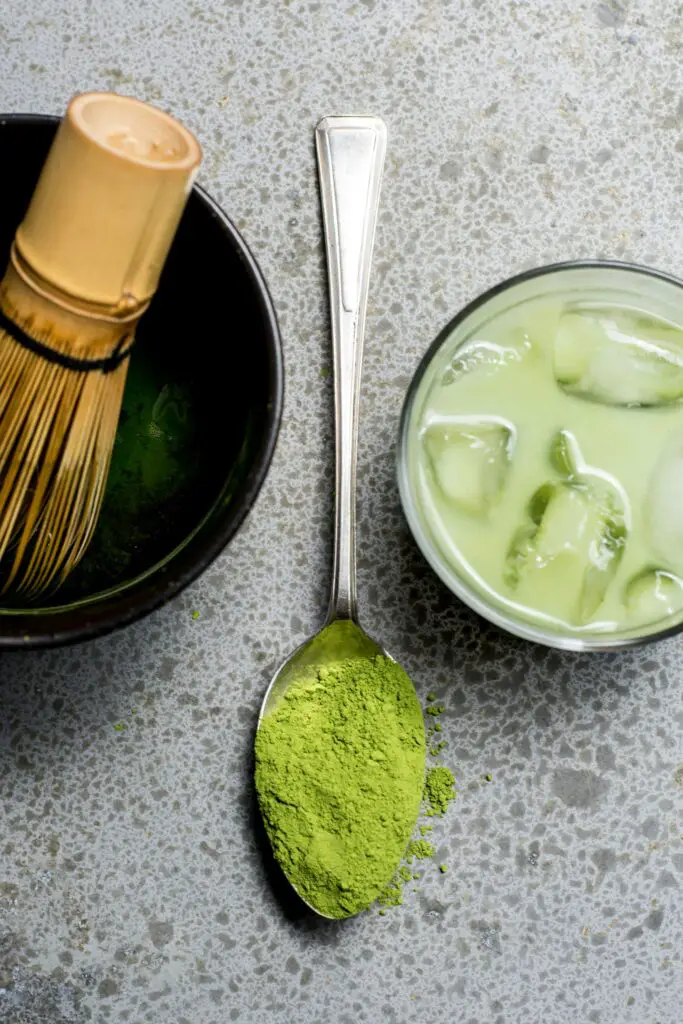
Antioxidants
One of the primary health benefits of matcha is its high antioxidant content.
Matcha is rich in catechins, particularly EGCG (epigallocatechin gallate), which are known to fight free radicals in the body.
This can help reduce inflammation and lower the risk of chronic diseases such as heart disease and certain cancers.
The fine grinding of green tea leaves to make matcha ensures that you’re consuming the entire leaf, which boosts its antioxidant content far beyond that of regular brewed green tea.
Caffeine Content
Matcha contains a moderate amount of caffeine, making it a great alternative to coffee.
In comparison to coffee, which often contains around 95 milligrams of caffeine per cup, a typical serving of matcha boba tea (using 1-2 teaspoons of matcha powder) contains roughly 70 to 140 milligrams of caffeine, depending on how much matcha is used.
The caffeine in matcha also provides a more sustained energy boost, thanks to the presence of L-theanine, an amino acid that promotes calmness without causing the jittery feeling associated with coffee.
Nutritional Value
A typical serving of matcha boba tea, made with plant-based milk like almond or oat, contains around 170-230 calories per serving, depending on the ingredients used.
The macronutrient breakdown includes a balance of carbohydrates from the tapioca pearls and sugars, as well as some fats and proteins from the plant-based milk.
Matcha itself is low in calories but contributes valuable micronutrients like vitamins A and C, potassium, and small amounts of protein.
Conclusion
Making matcha boba tea at home is quick, easy, and gives you full control over the ingredients.
You can customize everything from the sweetness to the type of milk, ensuring that each cup suits your taste perfectly.
Plus, it’s a cost-effective and fun way to enjoy this trendy drink.
Don’t hesitate to experiment with different flavors, like adding fruit purees or trying new milk options.
Every tweak can make the drink your own.
If you try this recipe, share your experience or customizations with us!
We’d love to hear how it came out!
FAQs
How long does matcha boba tea last?
Matcha boba tea can be stored for up to 24 hours in the refrigerator, but the texture of the tapioca pearls won’t hold up as well.
For the best experience, consume the tapioca pearls immediately after preparation, as they tend to harden and lose their chewiness over time.
Store the tea separately from the boba if you plan on drinking it later.
Is matcha bubble tea healthy?
Matcha bubble tea can be a healthy option, especially when you use natural sweeteners like maple syrup or coconut sugar and plant-based milks like almond or oat milk.
Matcha itself is packed with antioxidants and provides a moderate caffeine boost.
How to prevent boba from sticking?
To prevent tapioca pearls from sticking together, coat them in syrup immediately after cooking.
Once drained, stir the boba in a few tablespoons of syrup, such as brown sugar or maple syrup, to keep them soft and separate.
This step ensures they stay chewy and ready to enjoy.
